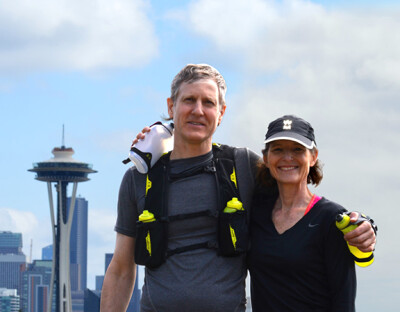As a mainstay accessory brand in a significant number of run specialty stores across America, Amphipod is a frequent add-on purchase, though not an afterthought. The fact that it was founded and directed by a woman makes it somewhat unique in the space, so Running Insight had a chance to visit with co-founder and president June Angus to get some insight into the brand.
Tell us a little of the history of Amphipod.
The company began in 1998 after my co-founder, Keith, and I were pondering during our daily runs about where to stash our keys, money and tunes, bounce-free. Other runners had the same issues. So we co-designed, engineered and patented the first Amphipod product – the MicroPack Pouch – and offered it to specialty running shops around the country.
How long have you been a runner?
I’ve been running since I was 14, initially training for other sports. Since co-founding Amphipod my personal running time has taken on a range of other dimensions, such as identifying problems runners have that can be addressed through product solutions, testing and creating brain space and time to explore ideas, product, process, manufacturing and market opportunities.
What is your actual title?
I am technically president and CEO; however, Amphipod is a pretty flat organization. We have a great team and all work together aiming to make operating a specialty store a better experience.
Amphipod has a boatload of patents. How many exactly?
Amphipod has 112 patents granted — and more pending. Protecting innovation has been important due to the amount of time and resources our team spends on innovating for the benefit of runners and specialty stores.
What is your design philosophy??
We’ve found developing effective running gear in the categories of hydration, storage and visibility requires a breadth of professional engineering and product development experience with design-for-manufacturing expertise. Making high-quality products cost effectively for a price that runners will pay and that stores can meet margin on is the secondary layer that really dials up the matrix of factors and can’t be separated from the product development process.
Does your input as a female runner complete the picture for your running products?
Being a runner has provided me with a more insight in product testing for products geared toward the female anatomy and generally a lot of food for thought on understanding the issues runners face that need to be solved, which helps complete the picture. Having worked across three different sporting goods companies all with different products, materials, technology and manufacturing requirements, I’m coming to the conclusion that being a user is helpful and informative, but somewhat secondary to professional expertise in developing and engineering complex specialized products.
How does your Seattle home base inspire your products?
The long, low-light and wet winters provide a lot of incentive for addressing the run-safety/visibility category and so many new and longstanding runners are embracing road, track and trails here that make it a great place to be involved in running community. The running and outdoor industry in the PNW is especially inclusive and the coffee-on-every-corner option helps rev up the afternoons on the shorter days of winter.
Were the past two years an uncomfortable pause or an opportunity to extend business?
It has been a great opportunity to learn, bend, empathize, ramp up team work and do all we could to be a resource and meet our customers’ changing needs. It afforded us the opportunity to innovate on process solutions, supply chain logistics, exercise agility, create products for even more new runners and the reminder that the best way to do things changes constantly.
So what does 2023 look like for your brand?
We have a great outlook on even more growth and expansion. Specialty stores and their customers are ramping up their embrace of smaller authentic brands that lead with quality and innovation.






